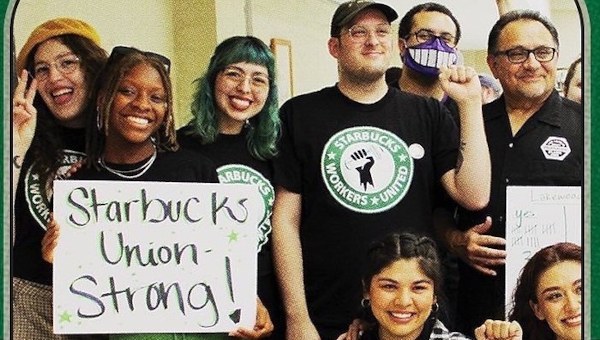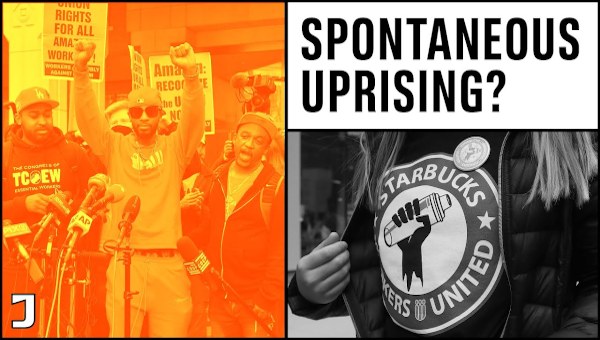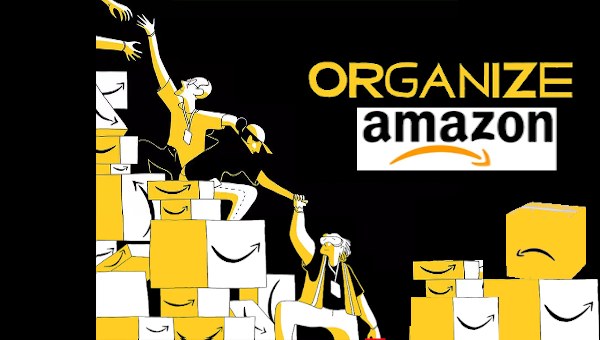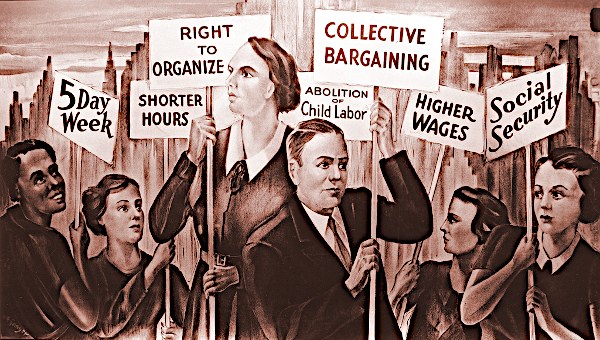Lessons for Organizing: From the Depression to Amazon and Beyond
Jonathan Rosenblum is a long-time union and community organizer in the US, particularly in Seattle and the Pacific Northwest. In part 1 of this interview, Jonathan spoke at length about Amazon’s recent NRLB settlement, and some of the obstacles to organizing at Amazon. Importantly, he also touched on the significance of unions having a sound organizing strategy that centres on building rank-and-file connections with and between workers.
In this second part of the interview, Tori Fleming and Matt Davis ask Jonathan further about union strategy, as well as, the degree of difference between labour legislation in the US and Canada, and the continued need to not just hope, but also to organize and fight for a better world beyond capitalism.
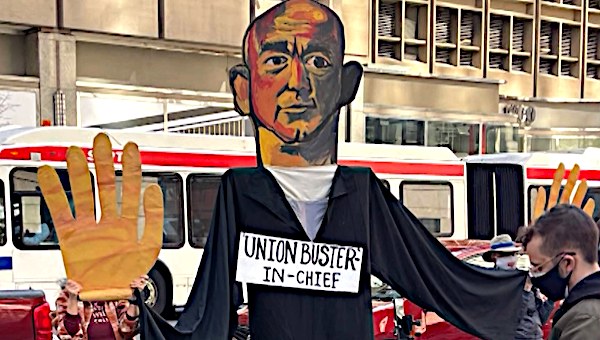
Matt Davis (MD): I’d like us to zoom out a bit to wider community support and public facing campaigns. What effect do you think public campaigns outside the workplace, such as the Fight for $15 or the struggle for universal healthcare, have on organizing inside the workplace? Do campaigns like these offer any openings for workers organizing at major employers like Amazon and Starbucks?
Jonathan Rosenblum (JR): That’s a really good question, Matt. To the examples you gave, I would also add the fight to eliminate student debt. The Joe Biden administration is resuming mandatory debt payments for millions of workers in this country, which is going to be economically devastating. The Biden administration has also ended the eviction moratorium protecting people from eviction, millions and millions of working class people are now in jeopardy of losing their homes. The struggle for voting rights is notable too, where we’ve seen a tremendous attack on basic voter rights in this country. That, of course, doesn’t affect the millionaires and the billionaires. Attacking voting rights affects working class people, especially in communities of color.
It’s not just things that outwardly seem purely economic, but a big social fight is important to organizing in a couple of ways. One is to the extent that it raises expectations for people that things can and should be better. That’s a good thing because it puts people into motion and into struggle. Another is that we can’t just simply have a campaign that exists on the communications level. Social struggles teach people the essential importance of organizing, and of building structures into that organizing. In the workplace you’ve got to build organizing committees. In the community, you also have to build similar groups of people who are grassroots leaders, who have the respect of their peers, and you can move the majority of people into action, as needed.
Teaching those basic lessons of organizing is so important. I’m noting this because, all too often, movement leaders think that all we need to do is get a righteous message out there, and people will follow. This was, by the way, a mistake that the organizers made in Bessemer, because they absorbed their own rhetoric, about how their fight is a righteous one. How it’s working class people going up against this Goliath. We’re on the right side of history.
Despite my critique, I want to be clear that I give credit to the organizers, who dove into this organizing, and notwithstanding the mistakes they made, they did it. I don’t see enough of that going on. It’s actually better to engage in the struggle, and to fall short than to say, this is too hard a problem, we’re not going to help the workers out in this situation. So good for them and good for the RWDSU for engaging in this fight. However, I hope they recognize that it’s not simply about the righteousness of the fight. You actually have to organize and build resilient structures to fight off the company and to prevail. That’s true whether it’s organizing in a workplace or the Fight for $15, or the student debt crisis, or voting rights.
MD: Considering your being in the States, and doing so much work with labor there, we wanted to ask you a question from a Canadian perspective. There is a distinction between what the so-called right to strike looks like in the US compared to Canada. Many believe that there is a fundamental right to strike in the United States, at least at most workplaces. Is it correct to think that such a right exists or is protected? Are there any major differences in the obstacles that Canadian or American workers face in organizing and do you have any thoughts on the organizing going on in Canada versus what we’re seeing in the United States right now?
JR: When I talk to Canadian colleagues and compare notes, I don’t see a fundamental difference in the legal regime around striking. I mean, there are certainly technical differences, but overall, it’s the same capitalism that we’re dealing with. Nominally, workers have the right to strike, but we all know that in practical reality, it doesn’t operate that way.
Let me just say a little bit for your readers and listeners about the right to strike in the United States. It is generally not protected, as a practical matter. It’s true that many so-called private sector workers have the legal right to strike, but it’s also true that all American businesses have the right to permanently replace and fire workers who go on strike. We’ve seen that the threat itself actually serves to neutralize strikes and actually prevent strikes by intimidating workers.
Importantly, many so-called private sector workers don’t enjoy any federal protections on the right to strike. Agricultural workers, gig economy workers, Uber and Lyft drivers, Instacart workers, truck drivers, all are excluded from federal labor law protections. By the way, if you did a racial analysis you’d find that disproportionately these are workers of color who are denied the right to strike. So, there is a racist component to the legal strike regime in this country. Federal government workers can’t strike by law. That’s also true for the vast majority of local and state government workers. In fact, in many cases public sector workers can’t even demand the right to bargain from their employer. Healthcare workers have to give 10 days’ advance notice before they strike, and there are restrictions on that even.
Notably, all airport workers and railroad workers basically have to get court approval before they can go on strike. Just to give you a concrete example, during the SeaTac Fight for $15, there was a group of fuelers at the airport who were so frustrated with the problems with safety and the abuse from supervisors that they sent a notice to their boss saying they’re going to go on strike if these problems aren’t fixed. These are people soaked in fuel by the end of their shift, who are working for poverty wages, running around trying to get planes fueled on time, tripping over operating equipment that was outright broken and dangerous. Rather than fixing the problems, the company went to federal court and got an injunction against the workers. The federal court said the workers may not strike, they may not have a sickout, they may not have pickets, they may not engage in any concerted activity to protect their rights.
It took us three years to get an appeals court to undo that adverse decision. What do you think happened to the workers and those problems in the meantime? Nothing happened to correct the issues raised and many of the workers got fired or pushed out the door. That’s the practical reality of the so-called right to strike in the United States. So we absolutely need to support workers who bravely do go on strike in the States, in Canada, and elsewhere. In particular, I want to note the John Deere workers, Columbia University graduate student workers, the grocery workers now on strike in Denver and elsewhere. We have to recognize that these strikes are not just over better contracts; they are examples of a direct challenge to the power of Capital.
We also need to take note that most of the leading strikes in this country in recent years were outright illegal or not protected by labor law. If you think about the 2018 West Virginia educators strike, in 55 counties, teachers, aides, bus drivers, cafeteria workers, all went on strike, not just for better contracts, wages, and benefits, but for smaller class sizes and increased staffing. Those 20,000 people who were striking were all violating state law that said you may not strike. That instigated and inspired similar education workers in Oklahoma, Kentucky, Arizona, and Colorado to also go on strike and demand a better public education system. Those were all illegal strikes as well, without legal protections for workers.
There’s a reason why the state tries to neuter and limit strikes in every capitalist country, because the bosses know that strikes have tremendous power. Effective strikes threaten profits, threaten the viability of business, and even threaten, in many cases, the political order. At its extreme, strikes call into question the very basic premise of labor exploitation; they get people asking basic questions about how power and wealth are distributed in society. That’s why strikes are so dangerous to political and economic elites, and why we have a legal regime that actively pushes workers away from that. As well as a court structure that actually actively tamps down strike threats. So, when workers do strike, we absolutely need to be there on the picket lines with them.
MD: Considering the generally anti-worker labor law regime that does hold back worker power both in the US and Canada, what would you say to those whose response to these challenges are needing to prioritize struggling around issues of labor law reform? Should labor law reform be a priority for those seeking to organize their workplaces or for those who wish to support that organizing?
JR: You’ll note that the West Virginia educators didn’t go to the state capitol demanding labor law reform, they demanded more money and smaller class sizes. That’s not to say that we shouldn’t argue and fight for labor law reform because it does reveal the contradictions of capital, like where there’s ostensibly the right to strike, as you’ve said, but in practical reality it doesn’t exist.
I want to walk people back to some recent history in the United States. If you’ll remember in 2008, as Wall Street was actively crashing the economy, we had an election here that Barack Obama won. One of the things that he said to unions was, if you vote for me, I will make sure that we pass labor law reform. It was called the Employee Free Choice Act (EFCA). And Obama won in November of 2008. The Senate was a majority of Democrats, 60 Democrats and 40 Republicans. The house was also overwhelmingly Democrat. There were a number of union leaders who had very high hopes going into 2009 when Obama was inaugurated. EFCA didn’t get passed. EFCA didn’t come anywhere close to getting passed, even though the Democrats had super majorities at the time. Instead, Obama and Congress spent more time propping up Wall Street and giving handouts to the billionaires who had crashed the economy. Meanwhile, tens of millions of Americans suffered, lost their jobs, lost their homes, many of them lost their lives. We still didn’t get labor law reform. For people who say we have to fight for labor law reform, I would say, look at what happened back then.
What we can achieve, whether it is at the bargaining table or in the political arena, is always a function of the balance of power between working people and the bosses. What we saw in 2009 was not just a sell out by the Democrats, who were happy to spout rhetoric but not deliver for working class people because they got our votes. We have to have a clear-eyed assessment that says, workers did not have the balance of power to prevail in that struggle.
It’s not a matter of electing Democrats or figuring out a different kind of policy to put forward. It’s a matter of building power at the grassroots, so that workers actually can prevail and create a different kind of society. Some of that may be done through legislative battles, but we’re not going to win those battles until there’s more organizing and a more powerful base. I also would say not just more organizing, but more demonstrated capacity to engage in militant strikes in the community and in the workplace, that force these concessions. Anything we win in the political arena is not because of the beneficence or the enlightenment of elected officials. It’s a concession to our power. We have to recognize that’s what it comes down to in the end.
Tori Fleming (TF): We want to pivot back a little bit and talk about strategy. What do you think it will take to actually unionize Amazon? We’ve frequently seen that unions can be very competitive over the chance to organize specific sectors. So, considering Amazon seems to be a pretty hot place to organize right now, do you think that unions need to cooperate to make a breakthrough within organizing at Amazon? How realistic is it to expect such a major breakthrough?
JR: I am hopeful when I hear some of the things that union leaders are saying about the need to organize Amazon, particularly the Teamsters Union. But I’m not sure that rhetoric matches up with the resource commitment that it’s going to take for the international labor movement as a whole to see organizing Amazon as an urgent priority. That’s sort of the view from the top down.
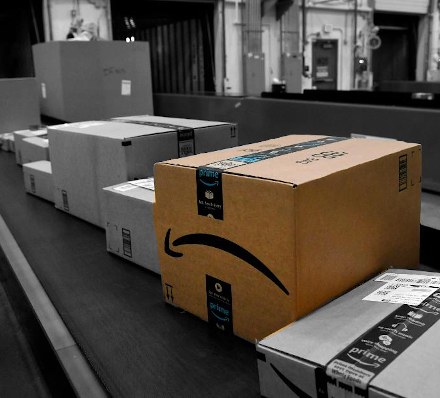
From the bottom, I would say I’m also very excited about a lot of the innovative organizing that’s happening at the grassroots, sometimes through institutional unions, and sometimes not. Workers at the grassroots have the creativity, imagination, and perseverance to figure out new models of organizing. A big part of the job of union institutions is to go talk to the workers, and more importantly, to listen to them and learn about tactics and strategies. They have to be accompanying workers, not dictating to workers, but accompanying them in the struggle to take on this behemoth, and figure out something that the working class hasn’t figured out in the history of the world yet.
There was a time when workers hadn’t yet figured out how to organize basic industry. We overcame that in the ’30s in the US, and right after that, in Canada. We didn’t overcome it by having teams of paid organizers parachute into cities and tell workers what to do. It came through a bottom-up process that combined knowledge and struggle. Workers had years and years of struggling through many losing battles. Famously the steel strikes of 1919-1921. They were losing strikes; people lost their jobs and lives. But workers in the ‘20s and ‘30s began to understand power, starting with auto. Those workers had an assessment of how you choke off production with sit-down strikes and other militant tactics to hurt the employer. Some of those kinds of tactics and strategy will work in organizing Amazon, and some of them won’t.
What capital learned from the struggles of the ’30s, is that you can’t allow your production process to become hostage to a militant group of organizers who can choke off your production and distribution networks. So now they build redundancy into those networks. Amazon is a classic example of it, where you could shut down an entire warehouse, but it won’t make a bit of difference to the company; they’ll simply shift distribution to another place. You could shut down a number of warehouses and it would barely register a blip. When workers in Germany go on strike at Amazon warehouses, Amazon simply shifts distribution to Poland. So, it’s not just a national problem.
For capital, borders have always been porous and will continue to be. You can’t distribute goods that are being ordered in the United States very easily from a warehouse in Thailand. But if workers at Seattle warehouses all go on strike, Amazon can get warehouses in British Columbia to cover for them. So, we have to have a recognition that while all organizing starts out locally, it has to be regional, national, and ultimately international in order to succeed. Moreover, there’s tremendous power – structural power – that some workers in Amazon have. If I’m a warehouse worker, I have very little structural power, but I might have some power if I can unite with everyone in my warehouse. Better yet if I unite with everyone in warehouses throughout the region. Tech workers have more structural power as individuals or small groups because of the specialized nature of the work that they do.
Just like how our predecessors in basic industry had an understanding of how to influence production and who has structural power and who doesn’t, we also have to have the same analysis, whether it’s organizing at Amazon, or Starbucks or any other big company. You have to start off with an analysis of power building, then organize from there.
TF: To build on that, Canadian labor history has come up a lot recently within socialist conversations as well as in other areas of organizing activity around Toronto. What specific lessons do you think Amazon organizers can draw from the unionization efforts of the ’20s and ’30s that you reference?
JR: The most important lesson is when workers unite and fight, we can win. We can do extraordinary things; we can transform workplaces and communities and even societies.
The second thing I would say is that it’s extraordinarily hard work and there are no shortcuts to organizing. You have to build structure, you have to form committees, you have to identify organic leaders, you have to recruit people, you have to struggle with people who may have a different understanding or political inclination. You have to engage with people, starting from where they’re at, listening, and then challenging them. Those are the basics, the day-to-day work of organizing, which is not about putting out a press release or simply positioning yourself morally. It’s about the grassroots organizing that needs to happen.
MD: Unfortunately, we’re nearing the close of our time here. As one final question, what would you say to organizers at places like Amazon in these trying times and who might be feeling positive about their chances of succeeding against these massive corporations?
JR: I would say that these are really, really scary times when you think about it. Not just the nature of work, but the climate crisis too. You see what happened in my state of Washington and just north of here in BC with the floods and fires last summer. The already obscene wealth disparity in this New Gilded Age is only getting worse, it’s even accelerated under COVID. The devastating human toll over the last two years has for many people ripped to shreds any illusion that US political and economic leaders – and Canadian ones for that matter – are really committed to meeting the basic health and safety needs of the population. We see ultra-right, anti-democratic, outright racist, and xenophobic groups striding boldly onto the political stage and into office. One can become very despondent at this moment.
Precisely because the crises are so grave, and severe and urgent, that’s why we need to organize. The only thing that’s going to save us, humanity, is the working class organizing and fighting for a different vision of society. And it starts in the workplace. It starts when you say, it’s not right that I’m making poverty wages, forced to walk or run eight miles a day through this cavernous warehouse, and subject myself to risk, danger, injury, and repetitive motion stress that is going to give me arthritis in a few years. There is a better way. But the only way we’re going to have that better way is if we join hands with other workers who are similarly facing the same situation. It starts in the warehouses; then it goes out from there.
The problems that I started off by noting are not going to get solved immediately. They’re not going to get solved with shortcuts, and they’re not going to get solved because some miraculous leader emerges from the mist to steer this country or this world in a different direction. It’s going to happen when we come together and build the mass movement and demand a different kind of society. That starts with the work we do day to day on the shop floor, convincing coworkers that we deserve better, and we should form a union. Only then can we build an understanding that we are all in the same class, and we better stick together, no matter our gender, race, religion, or where we come from. We have to unite everybody in a common enterprise that says we actually deserve more. •


